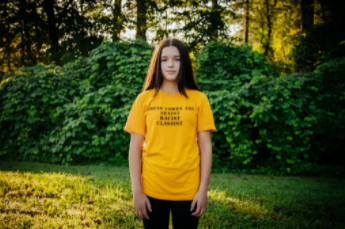Dress Code

October 5, 2021
Sophia Trevino very carefully picked out her outfit for the first day of school, with help from her mom and friends. She selected a white Los Angeles shirt and a new pair of ripped black jeans with Air Force 1 sneakers. Her parents didn’t think twice about her outfit choice. However, a teacher making sure students were in dress code, did not approve of her outfit. Trevino, along with many other students, were lined up, and she was asked to put her hands down to make sure the rip in her jeans was not lower than her fingertips. It was not. She and 15 other girls were written up before first period. Every Friday since then, Trevino and other students at Simpson Middle School have worn T-shirts that go against the dress code to protest it.
In an analysis of dress codes of 25 New Hampshire public schools, researchers found that they had policies specifically directed towards girls. In the study, they found that a lot of the garments prohibited in school policies, such as spaghetti strap shirts are “prohibited because they are sexy”.
“Dress codes are definitely sexist,” said Sabrina Bernadel, “They put the onus on girls to not be distracting or not call attention to themselves instead of putting the onus on all students to respect everyone’s body.” Onus means responsibility.
Bernadel said that when it comes to dress code violations, black and brown girls are written up the most, followed by black boys, and then white girls, and white boys. Code violations can make girls, especially black girls, “ashamed of how they express themselves and also what they look like”, said Ms. Bernadel.
“In school, they think boys are drooling over our shoulders and our thighs,” Trevino said, “They aren’t. And even if they are, that’s not our fault. That’s theirs.”
Trevino said that she has been joined by about 50 or 60 students, and she hopes that she can change the school dress code to something more gender neutral and fair, something such as “shirts, bottoms, and shoes”.
At Flagstaff Academy, two students sent an anonymous form to 18 students, asking them their opinion on dress code.
The first question was, “Do you think the dress code is unfair for female students?” 17 people said “yes”. 1 person answered “I don’t know”. The second question was, “Do you think that some people due to their body type have a harder time finding clothes?” 16 people answered “yes”. 2 people answered “I don’t know.” The third question was for female students only, “Do you have a hard time finding shorts that fit the dress code?” 14 answered “yes”, 1 answered “no”. The next question was a “MALE ONLY” question. “Do you find it distracting when the female students wear shorts above finger level?” 3 students answered “No, it doesn’t bother me but I do notice.” 2 students said, “No, I don’t even notice.”
Additional comments from the survey included, but are not limited to:
“I feel like tops that have prints on them should be considered school appropriate as long as the print is modest.”
“I think it’s unfair that we aren’t allowed to dye our hair, but it will only distract people for one day when they might compliment or notice somebody who dyed their hair. It’s also unfair to students and parents to have to dye their hair back, because it damages the child’s hair, and it costs a lot of money to dye hair.”
“It’s really unfair for the female students, and I think the school should realize female students’ shoulders aren’t distracting.”
“It’s super hard to find good shirts that don’t have print on them, and it’s middle school so it’s really nice to have fun shirts.”
Cites:
https://www.nytimes.com/2021/09/04/us/politics/mask-dress-code-protest.html
Lou Dworak, Student at Flagstaff Academy
Anna Archibold, Student at Flagstaff Academy

